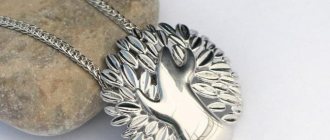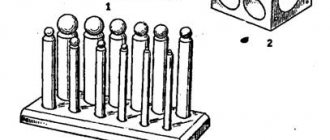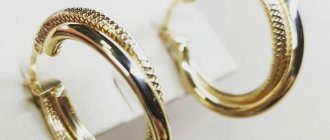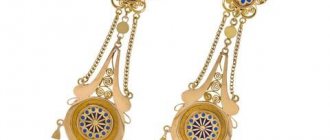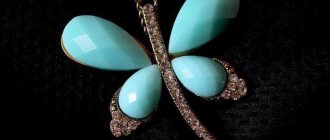Stages of creating gold jewelry by casting
What stages do Diva rings, earrings, bracelets and pendants go through before becoming yours?
- The designer creates a sketch of the future decoration. It can consist of one monolithic element, as in this engagement ring with diamonds, or several, which the installer will then combine into one - as in a pendant made of two rings with diamonds.
- Each element is cast in wax - the so-called. stencils.
- The waxes are assembled into a “herringbone” - each wax element has a leg, behind which they are soldered to the rod.
- Forming begins. The assembled “Christmas tree” is placed in a flask - a metal cylinder, after which it is filled with a special compound resembling clay to make a mold for casting.
- The flask is placed on a vibrating platform - shaking is necessary so that air bubbles come out of the composition, otherwise there will be voids in the casting molds, which will lead to defects.
- The flask is sent to the oven. At high temperatures (up to 1000°C), the composition sinteres, and the wax melts and flows out through the stem. The result is a casting mold, which is also often called a flask.
- After the mold has cooled, you can proceed directly to casting jewelry.
- The final stage of the work is assembly, processing, and fastening of the inserts.
A jewelry casting box is both a device for molding a casting mold and the result of this process: this is often what a mold for casting jewelry is called.
Primary sources
To determine what technology was used in the casting of icons in the 18th-19th centuries, let us turn to the primary sources - documents of that time. The “Decree on Copper Craftsmanship” (XVIII century) describes in detail all the stages of obtaining a mold for casting into the ground: “Then take the upper half of the flask and put it on a board and press the earth tightly...” In “History of the foundry of icons and crosses of a copper foundry Serova P.Ya., p. Krasnoye, Kostroma region” we read: “... For any kind of casting (thing) in a foundry, a model is needed for molding in the ground. And after extracting it from the ground, it forms a casting mold with all its exact outlines, which will be called a casting mold. Where the liquid metal will be poured and, upon cooling, it will take on a solid mass with its exact outlines.” Further: “... Molding mixture (clay and sand) …” In the article by G.I. Frolova “On the question of the technology of Vygov (Pomeranian) casting” contains lines from the inventory of the search of peasants in the Olonets province (a document from the mid-19th century): “Found: ... in a trough there is raw earth, used when casting crosses and crosses, on a shelf there are four iron flasks.”
All mentioned documents describe materials and technological aspects characteristic of a technology called earth casting (variants of the name: sand casting , sand-clay casting ). In “History of foundry business by Serov P.Ya. from the village of Krasnoe” there is a mention of the technology of casting using wax (lost wax) models, but it is noted that this technology was used only when obtaining a blank for the model.
Jewelry casting stage
The precious metal is loaded into a centrifugal casting machine. The flask is placed in a unit from which the air is pumped out. Helium is pumped into the created vacuum (it is useful not only for balloons). Molten gold is poured into the flask.
After pouring, the mold is removed from the installation and cooled - first with fans, then with cold water. The “clay” is washed away, leaving only the precious “herringbone” - almost finished rings, elements of earrings and pendants.
Sometimes stones are added at the casting stage. This technique is not used for precious stones: it is dangerous for natural minerals. For sapphires, diamonds, rubies and emeralds, stones are set by hand. But inexpensive inserts (mostly of artificial origin) can be filled with metal. Firstly, this reduces the cost of making jewelry, and secondly, today this technology is often positioned as a fashionable technique for creating designer jewelry, popular among novice jewelers.
Test yourself
Now that you have become familiar with the technology of making molds for casting icons in the 18th-19th centuries, remember the question asked at the beginning of this page. Perhaps you will already be able to give the correct answer to it.
When the molder turned over the molded lower flask, he saw that one of the models had shifted, and the casting could not be done (for example, the displaced model blocked the casting channel or the gap between the models had become so small that there was a risk of the mold breaking through in this place when pouring metal). Instead of remolding the bottom flask, the molder removed the displaced model, pressed it into the “correct” place and continued molding. But the first, “wrong” print did not completely disappear. As a result, a “double” image was formed in the mold, and then in the casting.
And this obvious defect, instead of being sent to the smelting furnace, ended up on sale. Apparently, contrary to the widespread myth about the highest responsibility of the masters of past centuries, some of them were not infallible workers, and they also had weaknesses. There is other evidence of this. But that's a completely different story...
Other materials in the section Copper cast icons, crosses, folds
- The subject diversity of Old Believer copper casting I: The history of icon casting. Image of Jesus Christ
- Subject diversity of Old Believer copper casting II: Image of the Blessed Virgin Mary
- Thematic diversity of Old Believer copper casting III: Holidays
- Subject diversity of Old Believer copper casting IV: Travel icons. Images of saints
- Information for copper cast collectors
- Unique colors of Russian enamel I: History of the Vygovsky monastery
- Unique colors of Russian enamel II: Pomeranian copper casting
- Unique colors of Russian enamel III: Moscow casting and other centers of Old Believer casting
- Pomeranian decrees on copper craftsmanship and the art of enamel (XVIII century)
- On the history of foundry of icons and crosses (early 20th century)
- Cross from Grandma's Chest: Pectoral Crosses
- Cross from grandma's chest: Icon crosses part 1
- Cross from Grandma's Chest: Icon Crosses Part 2
- Antsiferovo foundry masters
Finishing of jewelry
After casting and washing, the finished elements are sent for further processing - they are cleaned of casting flaws, ground and polished, rings are brought to the desired size, earrings and pendants are fastened into a single piece of jewelry (for example, like earrings with pearls on a pendant), precious inserts are added and sent to the Assay Office. There, jewelry is checked and receives a quality mark - an assay mark.
It should be noted that the final processing of high-quality jewelry and a mass product is different. Thus, for inexpensive jewelry, tumbling is used instead of manual grinding and polishing processes. The jewelry is placed in a centrifuge with an abrasive material, such as crushed nut shells or plastic granules. The quality of this processing is lower, but it allows us to offer the market cheap gold and silver jewelry.
The aerobatics of jewelry masters is setting. Even the most durable of gemstones, diamonds, will break if not handled carefully. The insert must be secured securely and at the same time delicately. This is painstaking handwork that requires endurance and amazing precision. Imagine how much time it took to create this 2-finger snake ring with emerald eyes and white and black diamond scales! Only top-class craftsmen work with precious stones. Hand tack does not compare to machine tack. The latter cannot provide a reliable result, but provides great savings.
"Incorrect" terms
Looking through messages on forums dedicated to metal-plastic, reading articles about copper casting, sometimes you come across such phrases as “made a matrix”, “cut out a mold”, etc. Now you know that if we are talking about cast icons of the 18th-19th centuries, then there is either an incorrect use of terms or an incorrect understanding of the casting technology of that time. A matrix (in metal processing) is a part of a casting mold (or stamp) that has a mirror image of the part being cast, which determines the shape of the future casting.
Repeated clarification: when casting icons of other centuries, as well as for casting pectoral crosses, in addition to the described technology of casting into the ground, other casting technologies could be used (although the main one was still casting into the ground).
How jewelry casting technology is simplified
As you already understand, the full cycle of casting gold jewelry is a labor-intensive process that requires a high level of technology and expensive equipment. However, not only large jewelry companies, but also private jewelers offer to make a ring or earrings to order. Is the workshop of each of them really equipped as well?
Of course not. Jewelry casting is a popular technology, and therefore jewelers who do not want or cannot carry out a full production cycle use ready-made “semi-finished products”. Disposable jewelry casting mold is a product that can be purchased inexpensively in China. Ready-made waxes are also offered. If you go to a forum or VK group where private jewelers communicate, you will see many advertisements like “I’m looking for such a mold” or “Does anyone have a wax frame with the coat of arms of the USSR?”
You need to understand that casting custom-made jewelry in ready-made flasks or using ready-made wax molds cannot be called an author’s work based on an individual sketch, because the product is created according to a template. If your goal is to save money, it may be cheaper to make a custom ring using a ready-made flask than to buy the same ready-made one in a store. However, you need to look at things soberly and understand that such jewelry cannot be called exclusive. But the quality of casting using a Chinese disposable mold leaves much to be desired.
The St. Petersburg plant Diva is a full cycle production of gold jewelry. Our collections are made according to original sketches by Diva artists in small editions. Our principle is the combination of new technologies and current trends in design with the traditions of the old jewelry school. That's why we don't use automation where manual labor provides better results. We also make exclusive gold jewelry to order.
Problem
| An icon with a “double image” defect from the “Christianity in Art” forum | An icon with a similar defect from the collection of the Solovetsky Museum |
Once on the forum of the website “Christianity in Art” a question was asked about how a double image could be obtained on a cast icon. If you are able to confidently explain the appearance of such a defect, then it most likely makes no sense for you to read further text. For those who cannot give a confident answer to this question, we suggest that you familiarize yourself with the technology of casting icons in the 18th-19th centuries. By the way, the answer to the question asked was never received on the forum.
Jewelry in Russia in the 19th century
In the 19th century, Russian jewelry art developed within the framework of a pan-European tradition and practice, which was reflected both in the range of jewelry and in their stylistic connection with the main styles of the era - from the Empire style, through all the “historical” styles (neo-baroque, neo-rococo, neoclassicism, etc. .) to modernity. The connection with pan-European traditions was also evident in the production organization system, which included both small jewelry workshops and large jewelry firms - C. Faberge, P. Ovchinnikov, I. Khlebnikov, the Grachev brothers, etc.
Gold and silver chains. XIX century.
One of the main and characteristic features of the development of jewelry in the 19th century in Russia is the creation of large factories equipped with new mechanical equipment and employing craftsmen of various specialties. These factories carry out a significant portion of the jewelry production, often made from designs by famous artists. Jewelers who are not part of the staff of large enterprises unite into artels or small jewelry workshops.
Individual production, characteristic of jewelry in the 18th century, was almost never carried out in the 19th century: single craftsmen hardly worked.
Jewelry of the 19th century does not have individual characteristics to the extent that Russian jewelry had in the 18th century - it is not the products of different masters that differ from each other, but only the products of different companies and artels, competing with each other, constantly following fashion, inventing what something new. Along with custom-made and expensive items, cheap jewelry for the mass consumer is produced in large quantities. In the second half of the 19th century, the artistic quality of local jewelry gradually decreased - local craftsmen could not compete with capital firms. They were mainly engaged in repairing and producing small jewelry.
In the 19th century, foreign masters were being replaced by Russians. The demand for jewelry is mainly satisfied by the products of domestic enterprises. According to the Ministry of Finance for 1893, the need for jewelry in Russia was satisfied by its own production by 94.3%. The export of Russian jewelry abroad was also significant. All-Russian and International exhibitions served as a kind of stimulus for the development of Russian jewelry art. The first exhibition in Russia took place in 1829 in St. Petersburg, then exhibitions were held every two to four years in St. Petersburg and Moscow. Russian jewelry was repeatedly exhibited at foreign exhibitions in Paris, London, Stockholm, Chicago, and was awarded gold and silver medals.
Earrings. Gold, silver, glass, rhinestones. First half of the 19th century.
Russian jewelry art in the 19th century was complex and varied in different periods of this century: it changed along with the costume in accordance with fashion. The number of jewelry, its shape, method of wearing, etc. – all this is clearly visible in the portraits of the 19th century.
Jewels were the class, family and personal pride of rich people, so artists had to carefully reproduce them in portraits. The costume varied depending on the class: the upper classes followed European fashion, the lower classes were more traditional.
In the 19th century, the leading role passed to women's costume: a woman in this century becomes, as it were, an advertisement for her husband's wealth and position in society. Throughout the 19th century, men's costume changed only in details, while women's costume responded to all new trends in art. An infinite number of forms of clothing (business, casual, summer, ballroom, city, “country”, etc.) also implied corresponding sets of jewelry. Jewelry was divided into ceremonial, which contained many precious stones (parures, combs, earrings, bracelets, rings), ordinary - for visits and small receptions (earrings, brooches, bracelets, chains, rings), everyday (brooches with Florentine mosaics, earrings and rings with semi-precious stones).
At the beginning of the 19th century, the traditions of 18th century jewelry continued in jewelry art. Classicism is entering a period of maturity, and a growing passion for antiquity is manifested in costume and the nature of jewelry. Before the War of 1812, light dresses were in fashion, worn over a cambric shirt or pink tights, so that the figure showed through the fabric; These clothes were accompanied by special “antique” hairstyles and jewelry (earrings, rings, light bracelets). The most typical and integral part of women's clothing of this time is the shawl, which was sometimes pinned with a brooch. The brooch, which came into fashion in Russia back in the 18th century, became the most common decoration in the 19th century.
The desire for simplicity led to the fact that in the early years of the 19th century it was considered bad form to wear jewelry even to balls. Fashion includes diamond-cut steel jewelry, buckles, buttons, brooches, and bracelets. Dresses were embroidered with steel threads instead of gold and silver threads.
Hair decoration in the form of two spikelets. Gold, pearls. First half of the 19th century.
1804-1811 - the time of formation in the Russian Empire style costume. There is a transition from the lightness of the beginning of the century to a clear geometry of forms, to rigor, restraint and monumentality. In 1806-1809 It is customary to wear rings on all fingers, for several hours, and many bracelets. Hairstyles are decorated with tiaras, gold hoops, wreaths of artificial flowers and golden ears of corn, gold and silver, oak and laurel leaves. But the neck and bare shoulders remain unadorned.
One of the most striking manifestations of fashion of this time was the fascination with carved stones - gems, which came from Europe back in the second half of the 18th century. Artistic stone carving has become an independent type of decorative and applied art in Russia. Cameos were created by the capital's best jewelers; they were brought in large quantities from abroad (both modern and antique).
For some time they eclipsed even diamonds, which were so popular in jewelry of the 18th century. They were collected, they were used to decorate tiaras, necklaces, pins, buckles, brooches, bracelets, and entire sets of jewelry were made from them. To create cameos, stones of different colors and transparency were used: layered agates and onyxes were very popular. In small decorations, cameos were the main and only detail. A thin gold or silver frame essentially served a utilitarian function, helping to secure the stone and connect it to the hairpin. In large jewelry, cameos, while maintaining a dominant role, combined well with pearls, diamonds and precious metals.
During the War of 1812 and after its end, a patriotic movement and a desire to revive national traditions arose. Dresses imitating a sundress and a shirt appeared, pearl jewelry came into fashion - it was a kind of play on folk art. Pearls are combined with expensive clasps made of precious metals and interspersed with diamonds.
Around 1814, a new trend emerged in fashion and jewelry - sentimentalism, with its cult of feelings and nature. The toilets of this time were characterized by an abundance of medallions with curls, mottos and miniatures, as well as bracelets, brooches and earrings woven from the hair of loved ones or the dead, decorated with gold frames and clasps. At this time, precious jewelry almost went out of fashion.
In the 1820s. Romanticism comes from Europe, with its appeal to the Western European Middle Ages, poeticization of antiquity, interest in history, craving for the fantastic, exotic, and whimsical. In jewelry of the 20s. XIX century, the proportions and restraint of classicism are still preserved; but the decorations are from the 30s. are already the embodiment of movement and grace. New types of jewelry are appearing, for example, the feronniere - a gem in a frame, descending onto the forehead and attached to a gold chain or hoop. The feronniere was combined with earrings or a brooch.
Bracelet. Gold, garnets. Mid-19th century. Russia.
Interest in the East led to the use of turbans and turbans made of oriental fabrics, decorated with precious agraphs, plumes of feathers, intertwined with pearls and gold chains as parts of the costume. The costumes of rich ladies at this time are replete with diamonds, sapphires, emeralds, rubies, as well as semi-precious stones that have become widespread - aquamarine, agate, topaz, carnelian, onyx; since the 1830s Garnet and coral are becoming popular. Sometimes the stones were placed in jewelry in such an order that the first letters of their names formed a name or motto.
Painted enamel continues to be used as decoration, on its own (for example, female portraits in men's rings), or as a background on which precious stones are fixed.
The growing skill of jewelers and passion for virtuosity lead to the appearance of jewelry in different techniques and from different materials. From Italy in the 20-30s. In the 19th century, there came a fashion for mosaic images made from the smallest pieces of smalt. Round, oval and square mosaic miniatures were inserted into rings, necklaces, and brooches. The subjects were architectural views and monuments, bouquets, birds, butterflies, etc. The frames were made of gold or silver.
Ladies wore a lot of jewelry for both evening and daytime dress; young girls were not supposed to wear expensive jewelry, especially with diamonds; they wore turquoise, corals, agates, semi-precious stones, velvet bracelets, enamel buckles, artificial and fresh flowers.
In the 1840s, another change in fashion occurred; at this time, images were created under the influence of the novels of Dickens and George Sand. The costume takes on a fragile and delicate design, and the huge sleeves and bows disappear. Hair is placed in a straight parting on both sides of the face. Jewelry of this time: a gold band around the bun, a brooch, paired bracelets made of agate or with black enamel. Little jewelry is worn with a day dress. Modest rings, tortoiseshell and hair bracelets, medallions with miniatures on a silk cord are in fashion. Cashmere shawls are pinned with a stone, portrait or cameo. Among the decorations of this time, medallions and brooches became established, which, although they change their forms, are preserved in the jewelry art of the early 20th century.
Earrings. Gold, diamonds. First quarter of the 19th century.
The 19th century in Russian jewelry was characterized by innovations in the technology of making things: mechanical methods of processing metal and finishing its surface appeared.
A fine relief is applied to silver by rolling the metal between steel rollers on which the desired design has been cut out - this is how stripes of repeat patterns are prepared for the details of rings, bracelets, and necklaces. By connecting elements together, jewelers created openwork chains, light, with two or three repeating elements.
In the art of the 1850-60s. Features of different styles intertwine, interest in Rococo appears, and products are created in the so-called “Russian” style. Women's fashion of this time borrows elements from men's costume, from the fashion of the 18th century, or from the national costumes of different nations.
The desire for elegance in the mid-50s of the 19th century turned into a pursuit of the conspicuous richness of the costume. Magazines and newspapers ridicule the excessive luxury of ladies' toilets. A lot of jewelry is worn with evening dresses: tiaras, brooches with pendants, rings with oval or rectangular stones in a narrow frame or in claws, bracelets, wide or flat, are in fashion. Small diamond clasps are worn on a black velvet ribbon around the neck or on a bracelet. Bracelets are worn two or three on each hand. Tiaras with aigrette and gold hoops were popular until the end of the 60s. In jewelry art there is a tendency to imitate the “natural” forms of flowers, leaves, ears of corn, bees, flies, birds, and snakes. An ordinary suit takes on the same appearance for different social classes, differing in the quality of fabrics, the skill of the tailor and the richness of decorations.
Judging by the portraits of the 50-60s. XIX century, ladies and girls wore earrings with pendants with a day dress, and in the second half of the 60s. – round earrings in the form of a double ring with corals, turquoise, pearls; the costume was complemented by a round or oval brooch, beads, and one or two bracelets. Rings were rarely worn, except for wedding rings. In the second half of the 60s. earrings, brooches, buckles and buttons appear in the “Russian” style made of colored stones or filigree enamel.
Bracelet. Gold, diamonds, glass. 1880-90s Petersburg.
During the day they wore jewelry made of semiprecious stones (jasper, garnet, amethyst, turquoise), amber, coral, mother-of-pearl, enamel, cameo. In the 60-90s. In the 19th century, exquisite dresses were in fashion - black velvet dresses trimmed with lace, accompanied by diamonds or pearls.
Ballroom toilets 1870-90s. mostly with short sleeves or without, which made it possible to wear elegant bracelets. With a large neckline, ladies wore necklaces with the same stones as in earrings and brooches. Girls wore a pendant or medallion on a gold chain or black velvet.
Ladies dressed in gold and velvet complemented their costume with tiaras with stones and pearls, and in addition wore lace or ostrich feathers pinned with a brooch; girls decorated their hair with hairpins in the shape of butterflies, dragonflies, birds, flowers, and in the 1880s. - in the form of an arrow or sword hilt. In the last third of the 19th century, filigree items such as bracelets, buckles, and buttons were very popular in Russia. Bracelets with stones in the shape of a snake, which wrap around the hand several times, are also in fashion.
Those who did not have real jewelry wore fake ones. The number of decorations was not limited by anything other than personal taste. A brooch, earrings, a watch chain, one or two rings, and a bracelet were worn with a day dress. Jewelry with precious stones was worn only with formal clothing. In the 70-80s. In the 19th century, round and oval black brooches with a pearl in the center or with a Venetian mosaic, black agate jewelry (earrings, brooch, ring, necklace), earrings with pendants in the form of rings studded with small precious stones, beads, brooches made of carved bone were in fashion. This could be worn with any dress.
The last twenty years of the 19th century wore everything that used to be, as well as brooches in the form of a crescent, horseshoe, bow or bouquet of gold and stones, pearls, coral; gold brooches with several links, ancient coins and medals set in gold. Narrow gold bracelets with two filigree balls hanging on thin chains are in fashion. At the end of the 1880s. – 10-15 thin bracelets on one hand. Tiaras in the 1880s not worn, but necklaces, brooches, earrings, bracelets are a must. By the 1890s the costume is simplified, and there is a tendency to minimize jewelry in everyday life. The last rise of jewelry art in Russia was at the turn of the 19th-20th centuries, a time when modernism was intricately combined in jewelry with various historical styles.
To the beginning of the “Jewelry” section>>>
Composition and properties of jewelry wax
A special material is used for waxing. It comes in several types. The main properties that high-quality wax should have:
- sufficient strength after curing to withstand post-processing of small parts;
- must melt without residual ash during the mold annealing process;
- the surface of the model made from jewelry wax must be even and smooth and should not stick to the molding materials;
- the melting point should not exceed 100 °C, and the softening temperature should not be lower than 35 °C.
The base of jewelry wax includes natural or artificial material with the addition of chemical components necessary to change the mechanical properties. The composition of the wax affects the following properties:
- hardness and softness;
- viscosity;
- elasticity;
- mechanical memory;
- fluidity in molten form;
- interaction with molding materials;
- hardening speed;
- shrinkage;
- waste-free;
- melting temperature.
Depending on the purpose, the jeweler selects the necessary wax for the job. There may be cases when a master mixes several types, for example, fusing small parts from a material of greater hardness onto a rod of softer wax to model.

